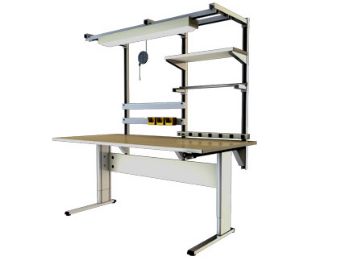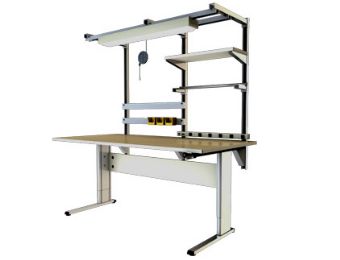


What is an Ergonomic Work Table?
Since businesses have an increased and vested concern regarding their employees’ well-being, many are equipping their work areas with ergonomic work tables. An ergonomic work table is one that can adjust to be more ergonomically correct and physically appropriate for each user and specified application, and there are many factors involved with the design of an industrial ergonomic table. Adjusting options may involve the table’s height and/or tilt angles, while others are modular pieces, with ergonomically designed shelves, equipment platforms and tool racks.
The most basic ergonomic work table consists of a tabletop which is adjustable in height, and can vary in format depending on the needs of the worker and the intended usage for the table. A recessed tabletop has a cutout where the worker sits or stands, others may have a tilting middle section. Sometimes manufacturers offer optional accessories, such as a flat panel monitor arm, bin rails, a light bar, a power strip, a tool balancer, or a wire spool holder.
A worker may typically adjust an ergonomic table to different heights throughout the course of the day, and one height adjusting option uses pins and pre-set holes. However, this is often difficult for one person to do alone, and is the most inconvenient. Another problem with this method is that one person cannot raise the tabletop with items still sitting on it. Therefore, some tabletops use a pin and spring system, spring-loading the adjustments necessary, more easily settling the pins into the holes. The hand crank system, also called a manual system, is an alternative to the pin system. The tabletop raises and lowers as the user cranks a handle; an upgraded variation of this crank system utilizes an electrically powered and controlled system, which is the easiest adjusting system to use.
An ergonomic work table may have one leg (called a pedestal style), two legs or four legs. Another style choice to determine is between a rolling/portable style and a stationary style of table. Several factors should be analyzed, such as the work environment and the specific tasks of the intended user. In industrial situations, engineers frequently study the job and the worker before designing a table that will reduce the risk of injury, increase the worker’s productivity, and maximize the environment’s efficiency.
Many times workers sustain injuries by stooping over their work, overreaching for items, or from standing or sitting too long. A properly designed table can help increase efficiency and decrease the risk of these types of injuries. Experts suggest measuring the distance from the floor to the worker’s elbows, and choosing a table height that is closest to that number. Another method of selecting the correct table height is to adjust the height so the worker’s wrists are straight or parallel to the floor while writing. And, a worker’s shoulders should be relaxed while standing or sitting.
Switching between sitting and standing helps the body resist fatigue and may reduce some muscle strain. Not all work tables have the range of movement to perform this adjustment, so it is advisable to research the limitations of the ergonomic work table for its height range. Other limitations include weight restrictions, so check to make sure the table can support the weight of the equipment and tools that will be placed on it. Some work tables support 300 pounds on the tabletop, while others can handle up to 900 pounds of equipment and tools.
Some manufacturers offer work tables that have a negative tilt because some experts suggest that slightly lowering the back edge to give the table a slight reverse tilt is helpful for human physical dynamics. A custom made ergonomic work table may have a specific size, worktop shape specification, and height range for a particular individual. Experts also advise that ergonomically correct settings for one person’s work style or body type may not be correct for other workers. Some tables allow for multiple adjustment settings to better accommodate workplaces with a variety of workers who will use the work table.
Rehabmart is pleased to carry superior quality and high performance ergonomic industrial workbenches from one of our highly regarded vendor, Ad-As.
Hulet Smith, OT
Rehabmart Co-Founder & CEO
lb